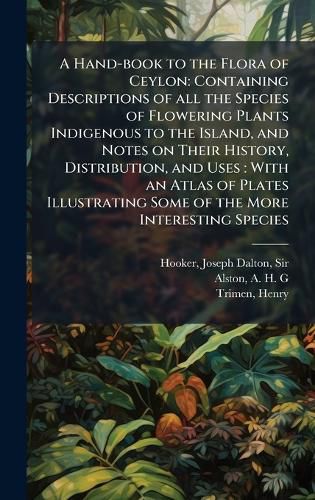Readings Newsletter
Become a Readings Member to make your shopping experience even easier.
Sign in or sign up for free!
You’re not far away from qualifying for FREE standard shipping within Australia
You’ve qualified for FREE standard shipping within Australia
The cart is loading…






This title is printed to order. This book may have been self-published. If so, we cannot guarantee the quality of the content. In the main most books will have gone through the editing process however some may not. We therefore suggest that you be aware of this before ordering this book. If in doubt check either the author or publisher’s details as we are unable to accept any returns unless they are faulty. Please contact us if you have any questions.
"A Hand-book to the Flora of Ceylon" is a comprehensive guide to the flowering plants native to the island, originally published in 1892. Authored by Joseph Dalton Hooker, Sir, A. H. G. Alston, and Henry Trimen, this volume offers detailed descriptions of each species, accompanied by notes on their history, distribution, and uses. This book provides an invaluable resource for botanists, researchers, and anyone interested in the rich botanical heritage of Ceylon (now Sri Lanka).
Featuring an atlas of plates illustrating some of the more interesting species, this handbook combines scientific rigor with accessible language, making it a vital reference for understanding the unique flora of the region. Discover the intricate details of Ceylon's plant life with this classic botanical reference.
This work has been selected by scholars as being culturally important, and is part of the knowledge base of civilization as we know it. This work was reproduced from the original artifact, and remains as true to the original work as possible. Therefore, you will see the original copyright references, library stamps (as most of these works have been housed in our most important libraries around the world), and other notations in the work.
This work is in the public domain in the United States of America, and possibly other nations. Within the United States, you may freely copy and distribute this work, as no entity (individual or corporate) has a copyright on the body of the work.
As a reproduction of a historical artifact, this work may contain missing or blurred pages, poor pictures, errant marks, etc. Scholars believe, and we concur, that this work is important enough to be preserved, reproduced, and made generally available to the public. We appreciate your support of the preservation process, and thank you for being an important part of keeping this knowledge alive and relevant.
$9.00 standard shipping within Australia
FREE standard shipping within Australia for orders over $100.00
Express & International shipping calculated at checkout
Stock availability can be subject to change without notice. We recommend calling the shop or contacting our online team to check availability of low stock items. Please see our Shopping Online page for more details.
This title is printed to order. This book may have been self-published. If so, we cannot guarantee the quality of the content. In the main most books will have gone through the editing process however some may not. We therefore suggest that you be aware of this before ordering this book. If in doubt check either the author or publisher’s details as we are unable to accept any returns unless they are faulty. Please contact us if you have any questions.
"A Hand-book to the Flora of Ceylon" is a comprehensive guide to the flowering plants native to the island, originally published in 1892. Authored by Joseph Dalton Hooker, Sir, A. H. G. Alston, and Henry Trimen, this volume offers detailed descriptions of each species, accompanied by notes on their history, distribution, and uses. This book provides an invaluable resource for botanists, researchers, and anyone interested in the rich botanical heritage of Ceylon (now Sri Lanka).
Featuring an atlas of plates illustrating some of the more interesting species, this handbook combines scientific rigor with accessible language, making it a vital reference for understanding the unique flora of the region. Discover the intricate details of Ceylon's plant life with this classic botanical reference.
This work has been selected by scholars as being culturally important, and is part of the knowledge base of civilization as we know it. This work was reproduced from the original artifact, and remains as true to the original work as possible. Therefore, you will see the original copyright references, library stamps (as most of these works have been housed in our most important libraries around the world), and other notations in the work.
This work is in the public domain in the United States of America, and possibly other nations. Within the United States, you may freely copy and distribute this work, as no entity (individual or corporate) has a copyright on the body of the work.
As a reproduction of a historical artifact, this work may contain missing or blurred pages, poor pictures, errant marks, etc. Scholars believe, and we concur, that this work is important enough to be preserved, reproduced, and made generally available to the public. We appreciate your support of the preservation process, and thank you for being an important part of keeping this knowledge alive and relevant.